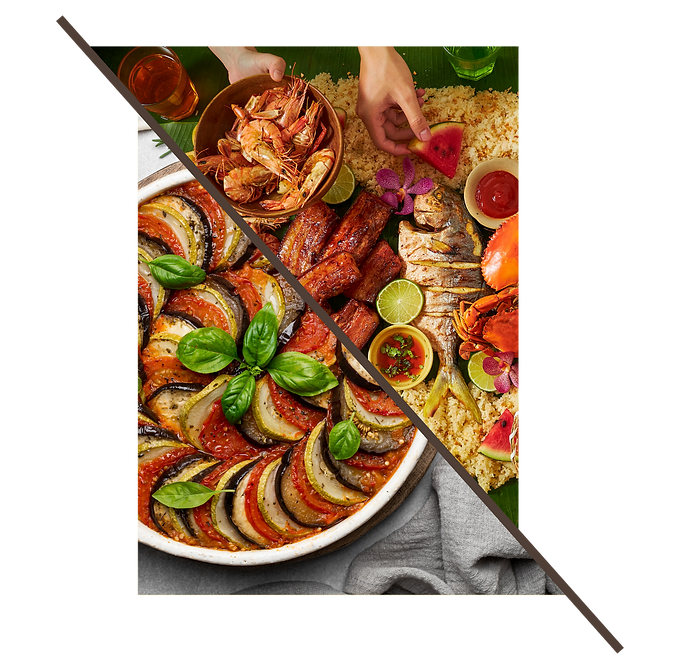.png)
CULTURE
From Fine Dining to Boodle Fights: How France and the Philippines Turn Every Meal into a Masterpiece!
BY ALTHEA TANJANGCO
January 2025
Picture this: a table filled with gourmet French delicacies, where every bite is a work of art, and a saucy and salivating Filipino feast where hands, laughter, and rice blend into one another. While these two contrasting meals may be thousands of miles apart, they both share one thing in common: their deeply-rooted love and tradition ingrained in food that turns every gathering into one that cannot be forgotten. From the pristine manner and elegance of French cuisine to the joyful chaos each bite of Filipino food brings, both cultures possess the ability to transform food into more than just a meal — they make it an experience.
Bonjour! Traveling all the way to France, meals are not taken lightly and are treated as nothing short of a sacred ritual. Once you take a seat at the table, you are not just “eating” — you are experiencing a carefully crafted culinary adventure. With their well-known multi-course affairs, each dish of theirs is carefully designed to create a balance amongst flavor, texture, and color. The French take immense pride in their culinary techniques, a result of the arrival of exotic flavors during the marriage of Catherine de Medici and French King Henry II in 1547!
From the world’s greatest rat movie, Ratatouille, we catch a glimpse of what French cuisine is all about — not just a rat in a chef’s hat, but the beauty and complexity in every bite. Dishes like coq au vin, bouillabaisse, and ratatouille highlight the French dedication to transforming simple ingredients into rich, flavorful experiences. Ratatouille, for instance, is a medley of vegetables like eggplant, zucchini, and tomatoes, each cooked with precision and seasoned out with utter balance! I’m no chef myself! But I can say that each dish is a masterclass in technique, patience, and balance—where every ingredient plays a part in creating a culinary masterpiece.
Mabuhay! People say, “It is more fun in the Philippines!” With the weather saying something else, how can we be so sure? Well, take a bite of Filipino food, trust that you will be in the best mood (Thank you for the applause).
Across the globe, food is equally celebrated but in a completely different way. For Filipinos, meals are communal and, often, hands-on. The “boodle fight” – a Filipino tradition where a large spread of food is placed on a banana leaf whilst everyone eats together with their hands – is the perfect example of how food brings people closer together. It is through the Chicken Insanal that you pass to your brothers and sisters, the Mang Tomas and Suka constantly being poured everywhere you look, the catch-up kwentos and chismis that leave no room for awkward silence, and the saucy hands that grab onto rice as if their life depended on it that the true purpose of food is brought to realisation: it is not just a moment of flavor, but a stronger force that deepens connections with surrounding people.
In France, the art of dining is something to be savored slowly, almost reverently. In the Philippines, meals are lively and full of energy, but the love and pride in the food is just as evident. While the French lean toward fine wines and meticulous presentation, and Filipinos may favor bold, exotic flavors served in what is seen as casual and, well, quite messy, both cultures act as a reflection of the world’s differences yet the beauty in that one subtle commonality. The commonality in which two parties are able to understand and share with one another through food, a universal language that transcends culture and tradition.
Of course, there is ALWAYS room for dessert. Luckily, France and the Philippines both have their own unique offerings in store for any sweet tooth. French pastries like eclairs, tartes, and the decadent crème brûlée are world-famous for their perfection, with flavors that range from rich and buttery to light and citrusy. On the other hand, Filipino desserts are a colorful and delightful mix of bold, tropical flavors. Whether it be the colorful and abstract nature of halo-halo, the crispy and sweet side-of-the-street banana cue, or the comfort-inducing magic of bibingka, all these tell a story of community, tradition, and the joy of sharing something sweet at the end of the day.
No matter where you are in the world, food has the power to turn an ordinary moment with people you see once a year or maybe, even, every day, into an unforgettable experience. Whether it is the crafted elegance of the French’s dining or the exciting and chaotic beauty of the Filipino’s boodle fights, both countries know how to transform the act of eating into a shared experience that celebrates connection, culture, and community, and that is the true work of art. Merci and Salamat!
.png)